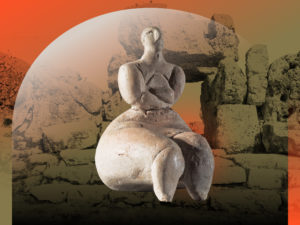
The summer exhibition ‘Temples of Malta’ at the Dutch Rijksmuseum van Oudheden (the national museum of antiquities) presents Malta’s rich prehistoric culture: a world of temples and tombs. The temples of Malta are the most ancient free-standing buildings in the world, 1,000 years older than the pyramids. In Leiden, archaeological finds from burial sites and sacred places will show how much the builders, Malta’s prehistoric farmers, were capable of achieving thousands of years ago. Their great engineering skills, their rituals, their religion, and the abrupt end of their way of life are still shrouded in a veil of mystery. The exhibition will run from 5 June until 31 October 2021. Tickets must be reserved prior to your visit at www.rmo.nl
___________________________
‘Temples of Malta’ is a survey exhibition about the culture of Malta’s prehistoric islanders from 3600 to 2500 BC, with a special emphasis on megalithic temples. A video feed from a robot camera hovering over temple models creates the illusion of visiting in person. The displays will also include parts of temple decorations, tools, decorated pottery, and jewellery. The final object in the exhibition will be one of the smallest and perhaps the most relevant to the present day: a two-centimeter-high sculpture from 3200 BC. Found at Tarxien Temples, it represents two people in a loving embrace – a timeless expression of the human need for contact and affection.
The exhibition design plays with the contrast between Malta’s colossal monuments and the small scale and intimacy of the objects found there. Large but sometimes also remarkably small, Malta’s famous ‘fat ladies’ owe that name to the lush curves of their bodies. But although these figures are usually seen as women, and sometimes even as mother goddesses, recent theories tell us they may well be men or asexual persons. The figures were found in graves and temples. Three examples will be on display in Leiden. The exhibition will explore the questions surrounding their appearance, their meaning, and their gender identity.
Temple culture
The group of Maltese islands, of which Malta and Gozo are the largest, lies just south of Sicily. They form a small country – about twice the area of Washington, DC, or slightly smaller than the Isle of Wight – but their earliest history is grand and intriguing. Malta was first settled around 5900 BC, probably by farmers from Sicily. Because of their isolation in the Mediterranean, the islands developed their own unique and fascinating culture between 3600 and 2500 BC (the Temple period). The largest and most striking remains are complex temple buildings from sites such as the UNESCO-recognized Ġgantija, Tarxien, Ħaġar Qim, Mnajdra, Ta’ Ħaġrat and Skorba, as well as underground burial sites (hypogea) carved out of rock. The largest stone is more than six meters long and weighs over twenty tonnes. Even now, little is known about the exact role of the temples or the rituals performed there. After almost 1,000 years of prosperity, the islands fell on harder times, and the temples and sculptures were deliberately damaged, broken, and burned. For a century, the islands appear to have remained uninhabited. This sudden end to the temple culture may have resulted from overpopulation and exhaustion of natural resources. Perhaps Maltese civilization was the victim of its own success.
Exhibition
Temples of Malta will run from 5 June to 31 October 2021. The exhibition will be accompanied by a booklet (Dutch and English) and a program of talks and guided tours, available both in the museum and online. Tickets must be reserved prior to your visit at www.rmo.nl.
The exhibition was made by Heritage Malta and the National Museum of Archaeology in Malta, in partnership with the Rijksmuseum van Oudheden. It features objects from Malta’s national collections and museums. The exhibition is supported by the Malta Tourism Authority. The Rijksmuseum van Oudheden is supported by the BankGiro Loterij.
______________________________

Image courtesy Rijksmuseum van Oudheden.
______________________________
Article Source: Rijksmuseum van Oudheden news release
‘Temples of Malta’, 5 June – 31 October 2021
Rijksmuseum van Oudheden, Rapenburg 28, Leiden, www.rmo.nl, facebook.com/Oudheden
______________________________
Advertisement





